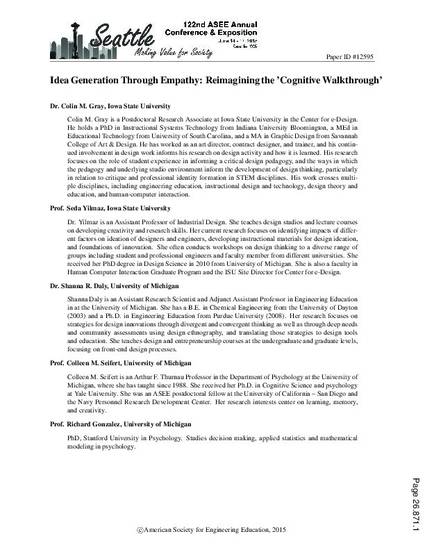
Article
Idea Generation Through Empathy: Reimagining the ‘Cognitive Walkthrough’
2015 ASEE Annual Conference and Exposition
Document Type
Conference Proceeding
Disciplines
Publication Version
Published Version
Publication Date
6-14-2015
Conference Title
122nd ASEE Annual Conference and Exposition
Conference Date
June 14-17, 2015
Geolocation
(47.6062095, -122.3320708)
Abstract
Idea Generation Through Empathy: Reimagining the ‘Cognitive Walk through’Students in engineering are required to evaluate their products against user requirements, but often, these requirements are abstracted from the user or context of use, making it difficult for students to empathize with the eventual user of the product or system they are designing. In previous research, we have demonstrated the use of Design Heuristics to encourage divergencein ideation at initial stages of the design process. Design Heuristics—a tool based on award-winning products and design activities of engineers and product designers (e.g., Yilmaz &Siefert, 2011)—has been extensively validated through empirical studies, shown to increase ideation capacity and flexibility. Use of this method has been focused primarily on early stage ideation, with less support for students who are iterating on or evaluating more developed concepts. Our proposal focuses on extending the student’s understanding of the problem space by generating empathy with the end user and context. Through this empathetic positioning, the Design Heuristics method can be used to lead to a richer space for additional idea generation.Typical uses of Design Heuristics in an engineering classroom context (e.g., Daly, et al., 2012)have not been situated in the context of use, thus operating at a level of abstraction above the user, context, or sociocultural milieu. One of the more significant insights to come out of the design community is the importance of problematizing the context and a rich understanding of the user and importing that information back into the design process (Beyer & Holtzblatt, 1996;Young, 2008). So while ideating with Design Heuristics allows for questioning on the component or feature level, traditional framings of this method have not encouraged the interrogation of the larger problem framing, or potential use cases and contexts within that framing.Usability testing methods such as contextual inquiry (Beyer & Holtzblatt, 1996), mental models(Young, 2008), critical incident analysis (Flanagan, 1954), and cognitive walk throughs (Spencer,2000; Wharton, Reiman, Lewis, & Polson, 1994) have been developed to foreground situated,user-centered perspectives of the design. We analyzed several of these user-centered methods common in other disciplines and then adapted the cognitive walk through for use in an engineering education context. This method was revised and extended to maximize empathy with the end user and context, in order to use these insights to promote a more situated form of idea development using the Design Heuristics cards.The cognitive walk through is a method to evaluate usability in software engineering (Spencer,2000), and includes: defining inputs, convening the walkthrough and working through definedaction sequences, recording critical information, and iteratively revising the product. For an engineering context, we adapted this method (Figure 1) to encourage targeted idea generation,while relying on less structured action sequences, with the “user story” as the primary form ofwalking through the concept from a user perspective. Figure 1. Revised cognitive walk through process.In this paper, we present several case studies of students using this method to expand their notion of situated use, demonstrating how it may have utility for importation into engineering contexts.Our early testing has indicated that this method stimulates empathy on the part of the student for the design context they are working within, resulting in a richer narrative that foregrounds problems that a user might address, which recursively encourages targeted idea generation. References Beyer, H., & Holtzblatt, K. (1998). Contextual design: Defining customer-centered systems. San Francisco, CA: Morgan Kaufmann, Daly, S. R., Christian, J. L., Yilmaz, S., Seifert, C. M., & Gonzalez, R. (2012). Assessing design heuristics for idea generation inan introductory engineering course. International Journal of Engineering Education, 28(2), 463.Flanagan, J. C. (1954). The critical incident technique. Psychological Bulletin, 51(4), 327-358.Spencer, R. (2000). The streamlined cognitive walk through method, working around social constraints encountered in a software development company. In Proceedings of the SIGCHI conference on human factors in computing systems (pp. 353-359). New York, NY: ACM Press. Yilmaz, S., & Seifert, C. M. (2011). Creativity through design heuristics: A case study of expert product design. Design Studies,32(4), 384-415. doi:10.1016/j.destud.2011.01.003Young, I. (2008). Mental models: Aligning design strategy with human behavior. Brooklyn, NY: Rosenfeld Media.Wharton, C., Rieman, J., Lewis, C., & Polson, P. (1994). The cognitive walk through method: A practitioner's guide. In Usability inspection methods (pp. 105-140). New York, NY: John Wiley and Sons.
Rights
© 2015 American Society for Engineering Education. Other scholars may excerpt or quote from these materials with the same citation. When excerpting or quoting from Conference Proceedings, authors should, in addition to noting the ASEE copyright, list all the original authors and their institutions and name the host city of the conference.
Copyright Owner
American Society for Engineering Education
Copyright Date
2015
Language
en
File Format
application/pdf
Citation Information
Colin M. Gray, Seda Yilmaz, Shanna R. Daly, Colleen M. Seifert, et al.. "Idea Generation Through Empathy: Reimagining the ‘Cognitive Walkthrough’" Seattle2015 ASEE Annual Conference and Exposition (2015) Available at: http://works.bepress.com/seda-yilmaz/15/

This is a proceedings from 2015 ASEE Annual Conference and Exposition, June 14-17, 2015. Post with permission.